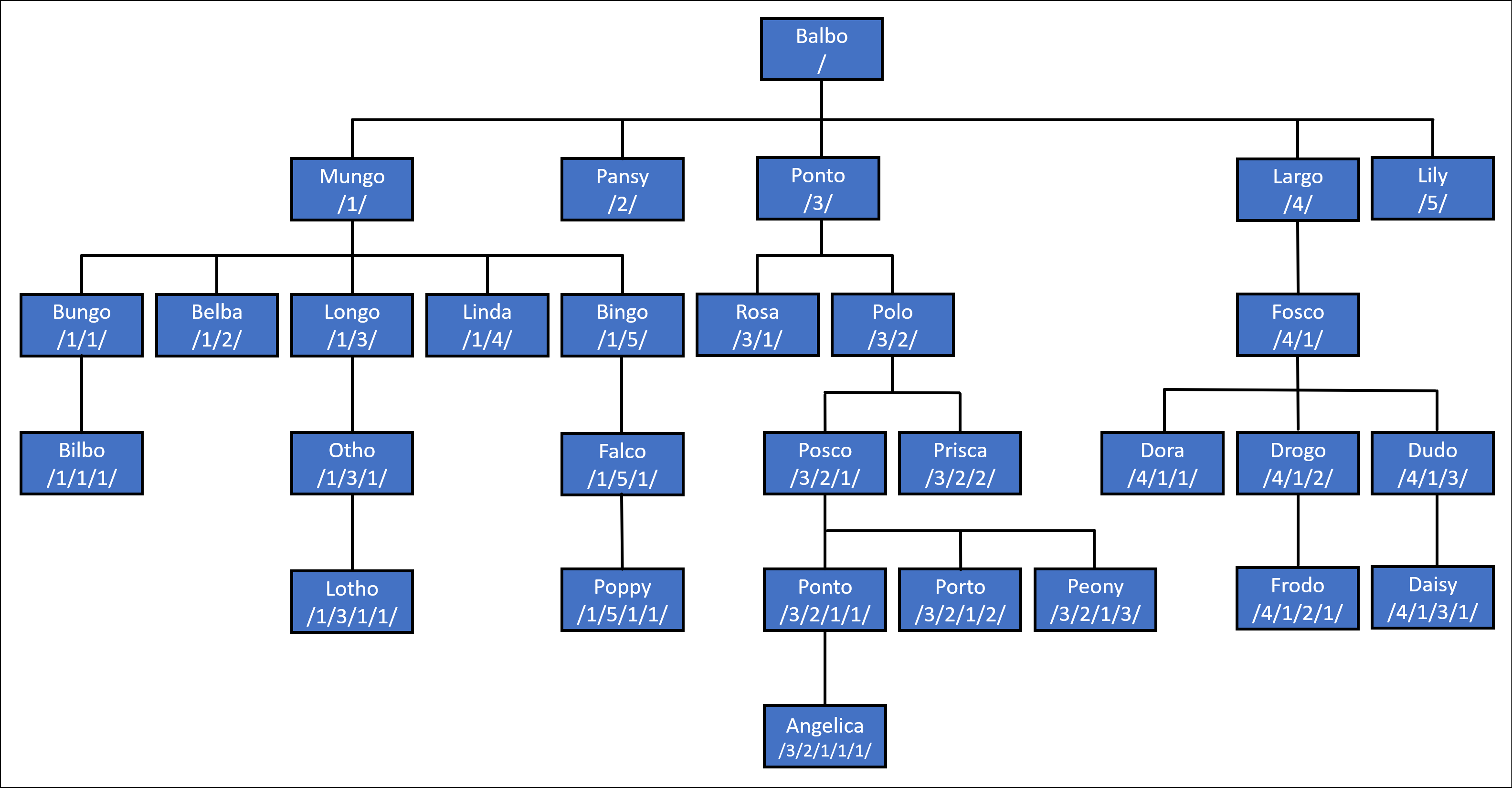SQL Server EF Core 提供程序中的分层数据
注意
EF Core 8.0 中添加了此功能。
Azure SQL 和 SQL Server 具有一个名为 hierarchyid 的特殊数据类型,用于存储分层数据。 在这种情况下,“分层数据”实质上是指形成树结构的数据,其中每个项都可以有父级和/或子级。 此类数据的示例包括:
- 组织结构
- 文件系统
- 项目中的一组任务
- 语言术语分类
- 网页间链接图
然后,数据库可以使用其分层结构对此数据运行查询。 例如,查询可以查找给定项的上级和依赖项,或查找层次结构中某个深度的所有项。
在 .NET 和 EF Core 中使用 HierarchyId
在最低级别,Microsoft.SqlServer.Types NuGet 包包含一个名为 SqlHierarchyId 的类型。 虽然此类型支持工作 hierarchyid 值,但在 LINQ 中使用它有点麻烦。
在下一个级别,引入了新的 Microsoft.EntityFrameworkCore.SqlServer.Abstractions 包,其中包括用于实体类型的高级 HierarchyId 类型。
提示
HierarchyId 类型更习惯于 .NET 标准,而不是 SqlHierarchyId 标准,后者是在 SQL Server 数据库引擎中托管 .NET Framework 类型之后建模的。 HierarchyId 设计为与 EF Core 结合使用,但它也可以在其他应用程序中的 EF Core 外部使用。 Microsoft.EntityFrameworkCore.SqlServer.Abstractions 包不引用任何其他包,因此对部署的应用程序大小和依赖项的影响最小。
对查询和更新等 EF Core 功能使用 HierarchyId 需要 Microsoft.EntityFrameworkCore.SqlServer.HierarchyId 包。 此包将 Microsoft.EntityFrameworkCore.SqlServer.Abstractions 和 Microsoft.SqlServer.Types 作为可传递依赖项引入,因此通常是唯一需要的包。
dotnet add package Microsoft.EntityFrameworkCore.SqlServer.HierarchyId
安装包后,通过调用 UseHierarchyId 作为应用程序对 UseSqlServer 的调用的一部分来使用 HierarchyId。 例如:
options.UseSqlServer(
connectionString,
x => x.UseHierarchyId());
层次结构建模
HierarchyId 类型可用于实体类型的属性。 例如,假设我们要为一些虚构半成年人的父系家谱建模。 在 Halfling 的实体类型中,HierarchyId 属性可用于查找家谱中的每个半成年人。
public class Halfling
{
public Halfling(HierarchyId pathFromPatriarch, string name, int? yearOfBirth = null)
{
PathFromPatriarch = pathFromPatriarch;
Name = name;
YearOfBirth = yearOfBirth;
}
public int Id { get; private set; }
public HierarchyId PathFromPatriarch { get; set; }
public string Name { get; set; }
public int? YearOfBirth { get; set; }
}
提示
此处和以下示例中显示的代码来自 HierarchyIdSample.cs。
提示
如果需要,HierarchyId 适合用作密钥属性类型。
在这种情况下,家谱以家庭的家长为根。 可以使用 PathFromPatriarch 属性根据树下的家长跟踪每个半成年人。 SQL Server 对这些路径使用压缩的二进制格式,但在使用代码时,通常要分析到用户可读的字符串表示形式或从中分析。 在此表示形式中,每个级别的位置由 / 字符分隔。 例如,请考虑下图中的家谱:

在此树中:
- Balbo 位于树的根处,由
/表示。 - Balbo 有五个孩子,由
/1/、/2/、/3/、/4/和/5/表示。 - Balbo 的第一个孩子 Mungo 也有五个孩子,由
/1/1/、/1/2/、/1/3/、/1/4/和/1/5/表示。 请注意,Balbo (/1/) 的HierarchyId是其所有孩子的前缀。 - 同样,Balbo 的第三个孩子 Ponto 有两个孩子,由
/3/1/和/3/2/表示。 同样,其中每个孩子都以 Ponto 的HierarchyId为前缀,表示为/3/。 - 树下方还有其他...
以下代码使用 EF Core 将此家谱插入数据库:
await AddRangeAsync(
new Halfling(HierarchyId.Parse("/"), "Balbo", 1167),
new Halfling(HierarchyId.Parse("/1/"), "Mungo", 1207),
new Halfling(HierarchyId.Parse("/2/"), "Pansy", 1212),
new Halfling(HierarchyId.Parse("/3/"), "Ponto", 1216),
new Halfling(HierarchyId.Parse("/4/"), "Largo", 1220),
new Halfling(HierarchyId.Parse("/5/"), "Lily", 1222),
new Halfling(HierarchyId.Parse("/1/1/"), "Bungo", 1246),
new Halfling(HierarchyId.Parse("/1/2/"), "Belba", 1256),
new Halfling(HierarchyId.Parse("/1/3/"), "Longo", 1260),
new Halfling(HierarchyId.Parse("/1/4/"), "Linda", 1262),
new Halfling(HierarchyId.Parse("/1/5/"), "Bingo", 1264),
new Halfling(HierarchyId.Parse("/3/1/"), "Rosa", 1256),
new Halfling(HierarchyId.Parse("/3/2/"), "Polo"),
new Halfling(HierarchyId.Parse("/4/1/"), "Fosco", 1264),
new Halfling(HierarchyId.Parse("/1/1/1/"), "Bilbo", 1290),
new Halfling(HierarchyId.Parse("/1/3/1/"), "Otho", 1310),
new Halfling(HierarchyId.Parse("/1/5/1/"), "Falco", 1303),
new Halfling(HierarchyId.Parse("/3/2/1/"), "Posco", 1302),
new Halfling(HierarchyId.Parse("/3/2/2/"), "Prisca", 1306),
new Halfling(HierarchyId.Parse("/4/1/1/"), "Dora", 1302),
new Halfling(HierarchyId.Parse("/4/1/2/"), "Drogo", 1308),
new Halfling(HierarchyId.Parse("/4/1/3/"), "Dudo", 1311),
new Halfling(HierarchyId.Parse("/1/3/1/1/"), "Lotho", 1310),
new Halfling(HierarchyId.Parse("/1/5/1/1/"), "Poppy", 1344),
new Halfling(HierarchyId.Parse("/3/2/1/1/"), "Ponto", 1346),
new Halfling(HierarchyId.Parse("/3/2/1/2/"), "Porto", 1348),
new Halfling(HierarchyId.Parse("/3/2/1/3/"), "Peony", 1350),
new Halfling(HierarchyId.Parse("/4/1/2/1/"), "Frodo", 1368),
new Halfling(HierarchyId.Parse("/4/1/3/1/"), "Daisy", 1350),
new Halfling(HierarchyId.Parse("/3/2/1/1/1/"), "Angelica", 1381));
await SaveChangesAsync();
提示
如果需要,十进制值可用于在两个现有节点之间创建新节点。 示例:/3/2.5/2/ 在 /3/2/2/ 和 /3/3/2/ 之间。
查询层次结构
HierarchyId 公开可用于 LINQ 查询的多种方法。
| 方法 | 说明 |
|---|---|
GetAncestor(int n) |
在层次结构树中向上获取节点 n 个级别。 |
GetDescendant(HierarchyId? child1, HierarchyId? child2) |
获取大于 child1 且小于 child2 的后代节点的值。 |
GetLevel() |
获取层次结构树中此节点的级别。 |
GetReparentedValue(HierarchyId? oldRoot, HierarchyId? newRoot) |
获取一个值,该值表示新节点的位置,该节点具有从 newRoot 开始的路径,该路径等于从 oldRoot 到该节点的路径,并且有效地将该节点移到这个新位置。 |
IsDescendantOf(HierarchyId? parent) |
获取一个值,该值指示此节点是否是 parent 的后代。 |
此外,还可以使用运算符 ==、!=、<、<=、> 和 >=。
下面是在 LINQ 查询中使用这些方法的示例。
获取树中给定级别的实体
以下查询使用 GetLevel 返回家谱中给定级别的所有半成年人:
var generation = await context.Halflings.Where(halfling => halfling.PathFromPatriarch.GetLevel() == level).ToListAsync();
它转换为以下 SQL:
SELECT [h].[Id], [h].[Name], [h].[PathFromPatriarch], [h].[YearOfBirth]
FROM [Halflings] AS [h]
WHERE [h].[PathFromPatriarch].GetLevel() = @__level_0
在循环中运行此功能,可以获取每一代的半成年人:
Generation 0: Balbo
Generation 1: Mungo, Pansy, Ponto, Largo, Lily
Generation 2: Bungo, Belba, Longo, Linda, Bingo, Rosa, Polo, Fosco
Generation 3: Bilbo, Otho, Falco, Posco, Prisca, Dora, Drogo, Dudo
Generation 4: Lotho, Poppy, Ponto, Porto, Peony, Frodo, Daisy
Generation 5: Angelica
获取实体的直接祖先
以下查询使用 GetAncestor 查找半成年人的直接祖先,给定该半成年人的名称:
async Task<Halfling?> FindDirectAncestor(string name)
=> await context.Halflings
.SingleOrDefaultAsync(
ancestor => ancestor.PathFromPatriarch == context.Halflings
.Single(descendent => descendent.Name == name).PathFromPatriarch
.GetAncestor(1));
它转换为以下 SQL:
SELECT TOP(2) [h].[Id], [h].[Name], [h].[PathFromPatriarch], [h].[YearOfBirth]
FROM [Halflings] AS [h]
WHERE [h].[PathFromPatriarch] = (
SELECT TOP(1) [h0].[PathFromPatriarch]
FROM [Halflings] AS [h0]
WHERE [h0].[Name] = @__name_0).GetAncestor(1)
对半成年人“Bilbo”运行此查询将返回“Bungo”。
获取实体的直系后代
以下查询也使用 GetAncestor,但这次用来在给定半身人的名字时查找半身人的直系后代:
IQueryable<Halfling> FindDirectDescendents(string name)
=> context.Halflings.Where(
descendent => descendent.PathFromPatriarch.GetAncestor(1) == context.Halflings
.Single(ancestor => ancestor.Name == name).PathFromPatriarch);
它转换为以下 SQL:
SELECT [h].[Id], [h].[Name], [h].[PathFromPatriarch], [h].[YearOfBirth]
FROM [Halflings] AS [h]
WHERE [h].[PathFromPatriarch].GetAncestor(1) = (
SELECT TOP(1) [h0].[PathFromPatriarch]
FROM [Halflings] AS [h0]
WHERE [h0].[Name] = @__name_0)
对半成年人“Mungo”运行此查询将返回“Bungo”、“Belba”、“Longo”和“Linda”。
获取实体的所有祖先
GetAncestor 可用于向上或向下一级进行搜索,或者实际上向上向下指定级别数进行搜索。 另一方面,IsDescendantOf 可用于查找所有祖先或依赖项。 例如,以下查询使用 IsDescendantOf 查找半成年人的所有祖先,给定半成年人的名称:
IQueryable<Halfling> FindAllAncestors(string name)
=> context.Halflings.Where(
ancestor => context.Halflings
.Single(
descendent =>
descendent.Name == name
&& ancestor.Id != descendent.Id)
.PathFromPatriarch.IsDescendantOf(ancestor.PathFromPatriarch))
.OrderByDescending(ancestor => ancestor.PathFromPatriarch.GetLevel());
重要
IsDescendantOf 为自身返回 true,这就是在上面的查询中筛选掉它的原因。
它转换为以下 SQL:
SELECT [h].[Id], [h].[Name], [h].[PathFromPatriarch], [h].[YearOfBirth]
FROM [Halflings] AS [h]
WHERE (
SELECT TOP(1) [h0].[PathFromPatriarch]
FROM [Halflings] AS [h0]
WHERE [h0].[Name] = @__name_0 AND [h].[Id] <> [h0].[Id]).IsDescendantOf([h].[PathFromPatriarch]) = CAST(1 AS bit)
ORDER BY [h].[PathFromPatriarch].GetLevel() DESC
对半成年人“Bilbo”运行此查询将返回“Bungo”、“Mungo”和“Balbo”。
获取实体的所有后代
以下查询也使用 IsDescendantOf,但这次用来在给定半身人的名字时查找半身人的全部后代:
IQueryable<Halfling> FindAllDescendents(string name)
=> context.Halflings.Where(
descendent => descendent.PathFromPatriarch.IsDescendantOf(
context.Halflings
.Single(
ancestor =>
ancestor.Name == name
&& descendent.Id != ancestor.Id)
.PathFromPatriarch))
.OrderBy(descendent => descendent.PathFromPatriarch.GetLevel());
它转换为以下 SQL:
SELECT [h].[Id], [h].[Name], [h].[PathFromPatriarch], [h].[YearOfBirth]
FROM [Halflings] AS [h]
WHERE [h].[PathFromPatriarch].IsDescendantOf((
SELECT TOP(1) [h0].[PathFromPatriarch]
FROM [Halflings] AS [h0]
WHERE [h0].[Name] = @__name_0 AND [h].[Id] <> [h0].[Id])) = CAST(1 AS bit)
ORDER BY [h].[PathFromPatriarch].GetLevel()
对半成年人“Mungo”运行此查询将返回“Bungo”、“Belba”、“Longo”、“Linda”、“Bingo”、“Bilbo”、“Otho”、“Falco”、“Lotho”和“Poppy”。
查找共同祖先
关于此特殊家谱的最常见问题之一是,“谁是 Frodo 和 Bilbo 的共同祖先?”可以使用 IsDescendantOf 编写此类查询:
async Task<Halfling?> FindCommonAncestor(Halfling first, Halfling second)
=> await context.Halflings
.Where(
ancestor => first.PathFromPatriarch.IsDescendantOf(ancestor.PathFromPatriarch)
&& second.PathFromPatriarch.IsDescendantOf(ancestor.PathFromPatriarch))
.OrderByDescending(ancestor => ancestor.PathFromPatriarch.GetLevel())
.FirstOrDefaultAsync();
它转换为以下 SQL:
SELECT TOP(1) [h].[Id], [h].[Name], [h].[PathFromPatriarch], [h].[YearOfBirth]
FROM [Halflings] AS [h]
WHERE @__first_PathFromPatriarch_0.IsDescendantOf([h].[PathFromPatriarch]) = CAST(1 AS bit)
AND @__second_PathFromPatriarch_1.IsDescendantOf([h].[PathFromPatriarch]) = CAST(1 AS bit)
ORDER BY [h].[PathFromPatriarch].GetLevel() DESC
使用“Bilbo”和“Frodo”运行此查询会告诉我们,他们的共同祖先是“Balbo”。
更新层次结构
常规更改跟踪和 SaveChanges 机制可用于更新 hierarchyid 列。
重新设置子层次结构的父级
例如,当 DNA 测试显示,Longo 实际上不是 Mungo 的儿子,而是 Ponto 的儿子时,我确定我们都记得 SR 1752(也称为“LongoGate”)的丑闻! 这场丑闻的一个后果是,家谱需要重新编写。 特别是,Longo 及其所有后代的父系需要从 Mungo 调整为 Ponto。 GetReparentedValue 可用于执行此操作。 例如,查询了第一个“Longo”及其所有后代:
var longoAndDescendents = await context.Halflings.Where(
descendent => descendent.PathFromPatriarch.IsDescendantOf(
context.Halflings.Single(ancestor => ancestor.Name == "Longo").PathFromPatriarch))
.ToListAsync();
然后,GetReparentedValue 用于更新 Longo 和每个子代的 HierarchyId,接着调用 SaveChangesAsync:
foreach (var descendent in longoAndDescendents)
{
descendent.PathFromPatriarch
= descendent.PathFromPatriarch.GetReparentedValue(
mungo.PathFromPatriarch, ponto.PathFromPatriarch)!;
}
await context.SaveChangesAsync();
这将生成以下数据库更新:
SET NOCOUNT ON;
UPDATE [Halflings] SET [PathFromPatriarch] = @p0
OUTPUT 1
WHERE [Id] = @p1;
UPDATE [Halflings] SET [PathFromPatriarch] = @p2
OUTPUT 1
WHERE [Id] = @p3;
UPDATE [Halflings] SET [PathFromPatriarch] = @p4
OUTPUT 1
WHERE [Id] = @p5;
使用以下参数:
@p1='9',
@p0='0x7BC0' (Nullable = false) (Size = 2) (DbType = Object),
@p3='16',
@p2='0x7BD6' (Nullable = false) (Size = 2) (DbType = Object),
@p5='23',
@p4='0x7BD6B0' (Nullable = false) (Size = 3) (DbType = Object)
注意
HierarchyId 属性的参数值以压缩的二进制格式发送到数据库。
更新后,查询“Mungo”的后代时将返回“Bungo”、“Belba”、“Linda”、“Bingo”、“Bilbo”、“Falco”、“Poppy”;而查询“Ponto”的后代时将返回“Longo”、“Rosa”、“Polo”、“Otho”、“Posco”、“Prisca”、“Lotho”、“Ponto”、“Porto”、“Peony”、“Angelica”。
函数映射
| .NET | SQL |
|---|---|
| hierarchyId.GetAncestor(n) | @hierarchyId.GetAncestor(@n) |
| hierarchyId.GetDescendant(child) | @hierarchyId.GetDescendant(@child, NULL) |
| hierarchyId.GetDescendant(child1, child2) | @hierarchyId.GetDescendant(@child1,@child2) |
| hierarchyId.GetLevel() | @hierarchyId.GetLevel() |
| hierarchyId.GetReparentedValue(oldRoot, newRoot) | @hierarchyId.GetReparentedValue(@oldRoot,@newRoot) |
| HierarchyId.GetRoot() | hierarchyid::GetRoot() |
| hierarchyId.IsDescendantOf(parent) | @hierarchyId.IsDescendantOf(@parent) |
| HierarchyId.Parse(input) | hierarchyid::Parse(@input) |
| hierarchyId.ToString() | @hierarchyId.ToString() |
其他资源
反馈
即将发布:在整个 2024 年,我们将逐步淘汰作为内容反馈机制的“GitHub 问题”,并将其取代为新的反馈系统。 有关详细信息,请参阅:https://aka.ms/ContentUserFeedback。
提交和查看相关反馈
